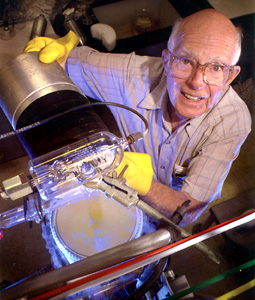Davis, Raymond, Jr. (1914-2006), an American physical chemist, won a share of the 2002 Nobel Prize in physics for work that gave rise to a field of science known as neutrino astronomy. The prize was also awarded to Japanese physicist Masatoshi Koshiba and the Italian-born American physicist Riccardo Giacconi. The new field gets its name from the object of its study—a subatomic particle known as a neutrino—and the fact that the neutrinos under study originate in astronomical objects, including the sun, other stars, and supernovae.

Neutrinos that originate in stars and supernovae are a result of a process called nuclear fusion. That process creates the tremendous energy of the sun and stars. In the late 1930’s, scientists had developed theories of how fusion occurs in stars.
In an experiment that began in the 1960’s, Davis discovered neutrinos from the sun. To make his discovery, Davis designed an unusual detector. Its main part was a tank that held 680 tons (615 metric tons) of tetrachloroethylene (C2Cl4), a liquid commonly used as a cleaning fluid. The tank was built in the Homestake gold mine in Lead, South Dakota.
Neutrinos interacted with chlorine (Cl) atoms in the liquid, changing them into atoms of argon (Ar). Davis developed a way to use helium gas to remove the argon atoms from the tank. Electronic devices outside the tank then counted those atoms.
Surprisingly, the devices counted only about one-third of the number of argon atoms predicted by the American physicist John N. Bahcall. Physicists currently account for the “missing” neutrinos by saying that neutrinos can change: There are three types of neutrinos. All the neutrinos that leave the sun are of one type, but two-thirds of them change their type on their way to Earth—and Davis’s equipment could detect only one type.
Neutrinos can change their type only if they have mass (an amount of matter). Neutrinos were once thought to be massless, and so Davis’s experiment led to a major change in scientists’ understanding of subatomic particles.
Davis needed to use an enormous quantity of C2Cl4 because neutrinos rarely interact with matter. The tank was built underground because particles other than neutrinos can convert Cl to Ar. The other particles are plentiful at and near Earth’s surface, but most of them cannot penetrate far into the ground.
Davis was born in Washington, D.C., on Oct. 14, 1914. He received a Ph.D. degree in physical chemistry from Yale University in 1942. He served in the United States Army Air Forces from 1942 to 1946, then worked in Dayton, Ohio, as a chemist for the agricultural company Monsanto. In 1948, he joined Brookhaven National Laboratory on Long Island, New York. He retired from Brookhaven in 1984, and in 1985, he became a research professor at the University of Pennsylvania. Davis died on May 31, 2006.
See also Astronomy (Neutrino astronomy) ; Koshiba, Masatoshi ; Neutrino .
